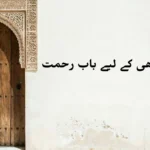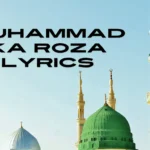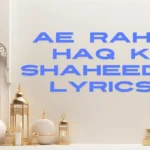Introduction
The commemoration of 12 Rabi ul Awal, known as the birth anniversary of the Prophet Muhammad (PBUH), is a time of immense joy and reverence in the Muslim world. One of the most cherished traditions of this celebration is the recitation of Naat Sharif, a form of devotional poetry praising the beloved Prophet.
| Mujhe Dar Pe Phir Bulana Lyrics in Urdu |
| ilahi Teri Chokhat Per Lyrics by Junaid Jamshed |
| Huzoor Aisa Koi Intezam Ho Jaye Lyrics |
| Tamanna Muddaton Se Hai Naat Lyrics |
Verse 1: **Sarkar apna rouza-e-anwar dikhaye,
Ham dard ke maro ko bhi Taiba buliaye.**
This verse is a heartfelt plea to the Prophet Muhammad (PBUH) to grant the vision of his Rouza-e-Anwar (blessed resting place) in Madinah. The poet’s words reflect the yearning of every believer to be called to Taiba (another name for Madinah), a city symbolizing peace, spiritual connection, and the love of the Prophet.
Relevance to 12 Rabi ul Awal:
This verse resonates deeply during Eid Milad un Nabi, as the day serves as a reminder of the Prophet’s unparalleled love and compassion for his followers. It is a call for spiritual proximity to him.
Verse 2: **Guzray hamari zindagi gumbad ke saye me,
Bas esi zindagi hame Sarkar chahiye.**
Here, the poet expresses a deep desire to spend life under the shade of the Green Dome (Gumbad-e-Khazra), a metaphor for the Prophet’s mercy and guidance. It symbolizes eternal peace and a life led by faith and devotion.
Thematic Importance:
This verse highlights the ultimate aspiration of a believer: a life guided by the values and teachings of the Prophet Muhammad (PBUH). It aligns beautifully with the celebrations of 12 Rabi ul Awal, which focus on rekindling faith and love for the Prophet.
Verse 3: **Aaqa yaha moujud hai Imaan hai mera,
Sab Ya Rasulallah ha ka nara lagayie.**
This verse speaks of the unwavering faith in the spiritual presence of the Prophet Muhammad (PBUH) in the lives of his followers. The call to chant “Ya Rasulallah” signifies the unity of the Muslim Ummah in devotion and remembrance.
Reflection for 12 Rabi ul Awal:
Chanting Ya Rasulallah and reciting naats are integral parts of Eid Milad un Nabi celebrations. This verse embodies the collective enthusiasm of the community during this occasion.
Verse 4: **Bigde huve banjayege sab kam dosto,
Muskil me zara aaqa ko dil se pukarye.**
This couplet reminds believers of the Prophet’s intercession and mercy. It assures that sincere calls for help, rooted in faith, will always find solace and solutions through the Prophet’s blessings.
Connection to Milad Celebrations:
During Mawlid, Muslims recount the countless ways the Prophet (PBUH) has inspired, guided, and healed humanity. This verse reinforces the belief in seeking his intercession.
Verse 5: **Jaye kahan dar chhod kar ham aap ka shaha,
Ham aasiyo ko apne daman me chhupaiye.**
This is a heartfelt acknowledgment of the Prophet’s unmatched compassion for sinners. The poet implores the Prophet to offer shelter under his protective care, reinforcing the theme of mercy central to his teachings.
Message for 12 Rabi ul Awal:
This verse encapsulates the Prophet’s essence as a mercy to all creation, a theme widely celebrated in Islamic poetry and especially during the joyous occasion of Eid Milad un Nabi.
Verse 6 (Refrain): **Sarkar apna rouza-e-anwar dikhaye,
Ham dard ke maro ko bhi Taiba buliaye.**
The Naat concludes by reiterating the heartfelt plea to be granted a connection to the Prophet and his resting place. This refrain ties all the verses together, emphasizing the central message of longing and devotion.
12 Rabi ul Awal Naat in Urdu


Related Themes and Their Significance
1. The Role of Naat in Eid Milad un Nabi
Naats are a medium to express devotion, convey spiritual messages, and unite the Ummah in celebration. They serve as a timeless tradition in commemorating the birth of the Prophet Muhammad (PBUH).
2. Celebration Through Poetry and Song
Islamic poetry, particularly Naats, captures the essence of love for the Prophet. The lyrical beauty and heartfelt emotions of this art form resonate deeply with believers.
3. Connection to Madinah
Madinah is often described as a spiritual home for Muslims. Naats glorifying the Gumbad-e-Khazra and Taiba evoke a profound sense of belonging and peace.
FAQs:
Reciting Naat on 12 Rabi ul Awal is a way to honor and celebrate the birth of the Prophet Muhammad (PBUH). It reflects love, devotion, and gratitude for his life and teachings.
The Green Dome symbolizes the Prophet’s resting place in Madinah, representing peace, mercy, and spiritual connection. It is a recurring theme in Islamic poetry and Naats.
Poetry, especially Naats, adds emotional depth to the celebrations, inspiring devotion and unity among Muslims while glorifying the life of the Prophet Muhammad (PBUH).
Conclusion
The 12 rabi ul awal naat is more than a poetic expression; it is a heartfelt tribute to the Prophet Muhammad (PBUH) and a reminder of his timeless teachings. By reciting and reflecting on such Naats, Muslims reconnect with their faith, strengthen their love for the Prophet, and unite in celebration of his birth. Let us embrace the profound beauty of these verses and the values they inspire on this blessed occasion.




